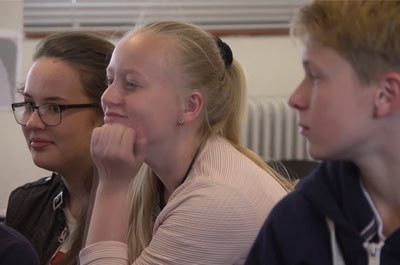Education, healthcare, and maybe your workplace? Can you hear the difference?
Acoustic improvement = life improvement.
In Part 1 of Better living through engineered room acoustics, we introduced Ecophon Saint-Gobain veteran Mai-Britt Beldam. The Market Development Manager speaks with conviction of the company’s mission to leave a “sound effect” on the people it serves and of her own multi-faceted role in bringing that mission to life: indeed, to lives.

Signe’s story
Isn’t it fun the way our minds, consciously or not, choose what’s interesting for us as individuals? Learning about the life-changing impact improved classroom acoustics made on a hearing-impaired Danish schoolgirl stayed with me more than just about any acoustic feat I’d read about to date.
My fascination with this story took hold when I heard Mai-Britt speak about it in her presentation Acoustics for Effective Learning Spaces; it subsequently grew with every follow-up story I could get my digital hands on.
Despite wearing hearing aids in both ears, young Signe found that classroom noise made it difficult for her to hear teachers and classmates. As she struggled to follow lessons and socialize with peers, Signe became increasingly despondent about going to school.
The 1960s-built classroom at Signe’s Kjellerup, Denmark school featured ceiling design we now know renders even sounds we’d expect to be unobtrusive inordinately loud and high-pitched.
”The old ceiling design made sounds high-pitched and harsh. A dropped pen was enough to create a noise”, says headteacher Lone Stig Andersen in the article Improved acoustics transformed Signe’s life. “I have experience working with hearing-impaired students and was aware of the poor acoustics. When I realized how it affected Signe, I really wanted to come up with a solution.”
Spoiler alert: happy ending
Ecophon Saint-Gobain partnered with Comfort Audio to give Signe’s classroom an acoustic makeover and hearing-enhancing products. Soon after project completion, Signe blossomed both academically and socially. Notably, all her classmates and teachers also found it much easier to thrive in the new acoustic environment.
But anyway…
In the interest of transparency, I do admit to knowing the story prior to e-conversing with Mai-Britt. But this knowledge compelled me all the more to get that inimitable personal take. Clearly, I had to bring up the Signe project in our interview:
Q: Can you tell me a little bit about your favourite room acoustic projects? I love the story of Signe and her classroom, especially the follow-up. What a difference those acoustic modifications made, not only for the young hearing-impaired student, but also for her classmates, teacher, and family! (Yeah, I actually got a little teary-eyed.)
“There is no doubt that the project involving Signe and her friends is one of my favorites,” Mai-Britt confirms. With blessings from municipal property management and educational authorities, the school had contacted Ecophon to discuss the problematic classroom acoustics.
A learning experience for everyone
Mai-Britt and her colleagues welcomed “the opportunity to develop testing material, as well as perform a really unique pilot based on our ideas and experience.”
“Because we calculate these sorts of parameters from the outset, we knew how our modifications would affect classroom acoustics,” Mai-Britt explains. “But we hadn’t anticipated how much we’d learn from working with the kids!”
“It was a very time-consuming project since we did almost everything ourselves,” Mai-Britt recalls. “For example, I recorded all the sound files for our tests, performed the testing, and analyzed the data. Then I tried to link my data to the room acoustic results,” she laughs, “while simultaneously tending to my daily work.”
“It was worth every second!”
Time-consuming—and often challenging—as Mai-Britt’s role in the classroom acoustics project was, the sound-savvy karate black belt reflects on it fondly. “Luckily, my manager was very supportive and agreed that this was a great opportunity to live up to our company goals, which are all about doing something good for people.”
“When I look back at the project, the most important results we achieved were the ones that couldn’t be measured. I will forever feel proud of investing our time in ways that improve lives. I have colleagues all over the world who work towards making people’s lives better; Signe’s story is one of many.”
And these days?
In the few years since the classroom acoustics improvements took place, Mai-Britt’s role has evolved, both to reflect her own professional growth and address the critical need for acoustic improvement in healthcare facilities.
“Recently, I’ve been working with numerous dementia clinics. This new ‘story’ is almost a rewrite of Signe’s—but this time, it’s about people suffering from dementia who can’t interact in their noisy care homes—until suddenly, something (i.e. room acoustics) changes, after which they feel better, safer, and willing to participate.”
“This story is also about doctors testing for cognitive deficits. The process is challenging when it’s unclear if the patients can’t hear what is being said, as opposed to not understanding or remembering it. Doctors literally run the risk of misdiagnosing.”
“It gives me the chills to talk about our healthcare-based projects. Not only have we seen first-hand how bad room acoustics make it impossible for patients to heal and recover; sometimes even operating rooms are acoustically troublesome to an extent that may result in surgical mistakes…a grim possibility indeed.”
Mai-Britt speaks highly of the end-user performance and well-being that’s formed the “backbone of [her] company since 1999 as well of “the great colleagues who have paved the way” for her. “I could never do this alone,” she says. “When I switched to healthcare, I studied what my predecessors had done and built on that. Today we have many important healthcare stories to share—stories about neonatal care, sleep disruption, and more.”
It’s all about Concept Development
Unique to their company structure, Ecophon Saint Gobain employs Global Concept Developers precisely to explore various industries, including education and healthcare, with a view to learning in-depth about those industries’ acoustic-related problems and needs. I’d hazard to guess one doesn’t simply walk into a leadership role within this sector:
A valued employee since 2007 when she started out in sales, Mai-Britt Beldam certainly didn’t!
“In June 2021, I passed on the healthcare ‘cape’ to another brilliant colleague who will take us to the next level and continue our journey,” she says.
Having proven her concept development mettle over the years in both educational and healthcare environments, Mai-Britt now oversees a team of concept developers in her role as Market Development Manager. We wish her continued success in all her endeavours. Hopefully, she’s taking some time for herself to play outside and chop things in half with her bare hands…just because she can and it looks really fun!
Many thanks for sharing your story, Mai-Britt.




